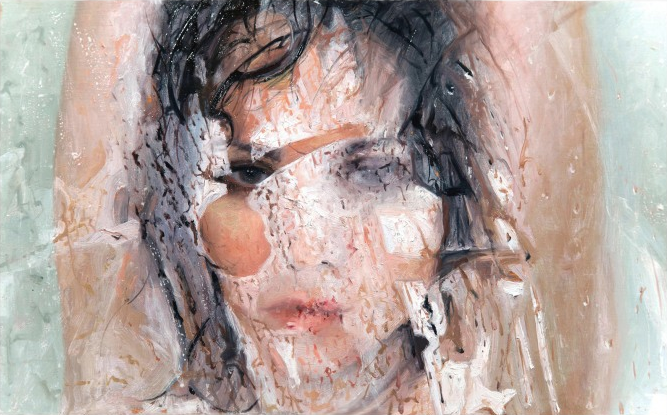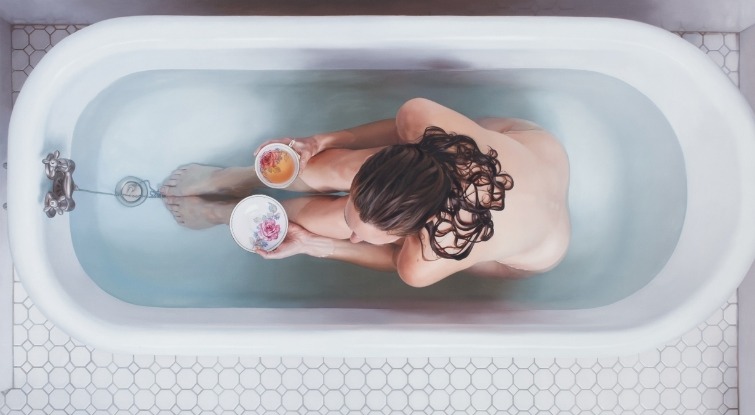
Photorealism, Hyperrealism or plain old realism, there are many artists working in this field. Moving away from abstract and expressionist forms, these are artists who recreate portraits and scenes to the finest detail, usually with a conceptual idea behind the piece.
Photorealism is not a new style of painting, the discipline started in the late 1960s with artists such as Richard Estes, Charles Bell and Chuck Close using the photograph as their starting point reproduced with paints or pencils.
The techniques also goes by the name hyperrealism and often involves the artist including a focus on the surface within the composition. Alyssa Monk, a leading light in the contemporary realism moment involved water surfaces and shower screens in many of her images, as seen below. She described why she came upon water as a subject for a ten year-long series of works: ‘I came upon it organically. I painted things that attracted me and when I tried water, I was very intrigued. Water allowed me to explore paint in experimental ways that kept me very focused and interested.’

Why Realism?
The New York-based artist has been painting in this field for nearly 30 years and her reasons for deciding to follow this style should be inspirational to any aspiring artist: ‘I followed what was attractive and exciting to me about paint, the versatility of the paint and the ability for it to transcend and become something else. I’ve been working on exploring how to put those two aspects into one canvas.’
Lee Price is another artist working in realism, she landed on this style through study and has since gone on to produce some deeply personal works. ‘I have always gravitated toward figurative painting. First, when I attended Moore College as a painting major and later when I studied independently with Alyssa Monks. The time I spent studying with Alyssa was extremely influential to my current style,’ Price told The Studio.
Price also explained the effect she wants to produce through her unnervingly naturalistic paintings:
‘I am trying to connect with my audience on a visceral level. I want them to feel that they are in the presence of the painting subject. In addition to painting in a realistic style, most of my paintings are life size. I do this to attempt to vanquish any sense of separation.’
Working Together
Both artists are advocates of working with other artists in a bid to move forward within an artistic discipline. Monks had this to say about such working relationships: ‘Teaching is an important way for me to connect with other artists and be influenced by their journey and struggles and engage more in the process of art making. I think of it as ‘The Art’, not my art or your art. We all know what it feels like to be very engaged in this process and how rewarding that flow experience is. I want everyone to have that. I know that great things come from that state of mind. I also know that the art world and art market make it difficult to get into that state. Teaching and connecting is one way to find it.’

Advice to Artists
Such communal working is amongst Monks’ advice to aspiring artists. ‘Take classes learning to draw and paint and sculpt from life. Try not to rely heavily on photographs. They make great tools, but not great teachers. Focus on the materials and expand your vocabulary on how to use them.’ Said Monks when offering tips to those looking to work in the realms of realism. She went on to advise ‘Experiment. Don’t try to come up with a style or voice or brand or idea. Lose yourself instead in curiosity for what attracts you. Play. Find flow. Look at paintings and films. Explore. What attracts others ultimately is your energy, focus, attitude, and enthusiasm, not your skill or your cleverness. Be yourself. Trust yourself. Don’t put pressure on your art to support your life, put pressure instead on your life to support your art.
Price also puts great stock in her time studying with Monks, her advice:
‘Study with an artist that you want to emulate. It has been my experience that this is how you learn. Then it is just a matter of putting the time into it.’
In the end, Monks believes the artist should work on their own terms: ‘You define your own success, not anyone else. For me, success is simply getting into the flow in the studio and making work that blows my own mind. The rest doesn’t define success for me. Learn what grit is and then embody it. Figure out how to stick with what you’re doing and follow through all the way.’